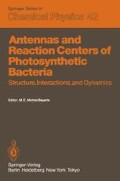Abstract
Phycobiliproteins are photosynthetic light-harvesting pigments in blue-green and red algae. They consist of 2–3 polypeptide subunits, each bearing up to 4 covalently bound linear tetrapyrrolic chromophores [1]. In vivo, the biliproteins are organized into complex structures [2], the phycobilisomes, which are attached to the outer thylakoid surface [3, 4]. Energy deposited in the phycobilisomes by light absorption is transferred mainly to photosystem II, which is located in the thylakoid membrane. To achieve efficient energy-transfer, the average excitation energy of the different chromoproteins in the phycobilisomes decreases with decreasing distance to the reaction center. It is generally assumed that the energy-transfer is based upon dipole-dipole-interaction (Förster mechanism). In order to elucidate the importance of the special arrangement of the biliproteins in the phycobilisomes, i.e. the fact that the building blocs of the antenna rods are hexamers, numerous fluorescence studies have been performed on functionally intact phycobilisomes, as well as on their constituent aggregates [4–12]. Apparent differences in the results were blamed on different origin (organism) or preparation procedures, different measuring conditions (low or high light flux with the possibility of nonlinear processes), different excitation and observation wavelengths, etc. In this contribution, we summarize our measurements of the fluorescence decay of phycobilisomes from Mastigocladus laminosus and their isolated constituent biliproteins. Special emphasis is thereby given on the additional information, which can be derived from the time-resolved fluorescence polarization. In contrast to earlier measurements [9–12], the excitation wavelength could be chosen down to 545 nm; furthermore, the phycobilisomes of the present mutant were free of phycoerythrocyanin; therefore a possible interference with the decay of this pigment was excluded.
Access this chapter
Tax calculation will be finalised at checkout
Purchases are for personal use only
Preview
Unable to display preview. Download preview PDF.
References
For a review see e.g.: H. Scheer, in: “Light Reaction Path of Photosynthesis”, p. 7, ed. by F.K. Fong (Springer-Verlag, Berlin, 1982)
E. Mörschel, W. Wehrmeyer: Arch. Microbiol. 113, 83 (1977)
For a review see e.g.: A.N. Glazer: Ann. Rev. Plant Physiol. 32, 327 (1983)
For a recent review see e.g.: “Biological events probed by ultrafast laser spectroscopy”, ed. by R.R. Alfano (Academic Press, New York, 1982)
J. Wendler, A.R. Holzwarth, W. Wehrmeyer: Biochim. Biophys. Acta 765, 58 (1984)
M. Seibert and J.S. Connolly: Photochem. Photobiol. 40, 267 (1984)
G.W. Suter, P. Mazzola, J. Wendler, A.R. Holzwarth: Biochim. Biophys. Acta 766, 269 (1984)
W. Haehnel, A.R. Holzwarth, J. Wendler: Photochem. Photobiol. 32, 435 (1983)
P. Hefferle, M. Nies, W. Wehrmeyer, S. Schneider: Photobiochem. Photobiophys. 5, 41 (1983)
P. Hefferle, M. Nies, W. Wehrmeyer, S. Schneider: Photobiochem. Photobiophys. 5, 325 (1983)
P. Hefferle, W. John, H. Scheer, S. Schneider: Photochem. Photobiol. 39, 221 (1984)
P. Hefferle, P. Geiselhart, T. Mindl, S. Schneider W. John, H. Scheer: Z. Naturforsch. 39c, 606 (1984)
G.R. Fleming, J.M. Morris, G.W. Robinson: J. Chem. Phys. 17 91 (1976)
J. Papenhuizen and A.J.W.G. Visser: Biophys. Chem. 17, 57 (1983)
T. Schirmer, W. Bode, R. Huber, W. Sidler, H. Zuber: J. Molecular Biology, submitted; id. in: “Optical Properties and Structure of Tetrapyrroles”, ed. by G. Blauer and H. Sund, (Walter de Gruyter, Berlin, 1985)
J. Wendler, W. John, H. Scheer, A.R. Holzwarth: submitted to Photochem. Photobiol.
T. Schirmer: PhD-Thesis, TU-München (1985)
Author information
Authors and Affiliations
Editor information
Editors and Affiliations
Rights and permissions
Copyright information
© 1985 Springer-Verlag Berlin Heidelberg
About this paper
Cite this paper
Schneider, S. et al. (1985). Picosecond Time-Resolved, Polarized Fluorescence Decay of Phycobilisomes and Constituent Biliproteins Isolated from Mastigocladus larninosus . In: Michel-Beyerle, M.E. (eds) Antennas and Reaction Centers of Photosynthetic Bacteria. Springer Series in Chemical Physics, vol 42. Springer, Berlin, Heidelberg. https://doi.org/10.1007/978-3-642-82688-7_4
Download citation
DOI: https://doi.org/10.1007/978-3-642-82688-7_4
Publisher Name: Springer, Berlin, Heidelberg
Print ISBN: 978-3-642-82690-0
Online ISBN: 978-3-642-82688-7
eBook Packages: Springer Book Archive

